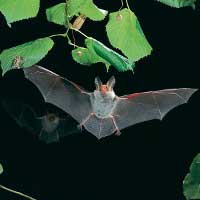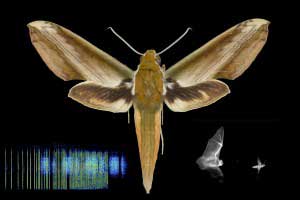** Flying on Instruments **
the vision of bats
Consider also sound based sonar vision in bats, smell warfare in skunks, porcupines, or the dam making ability of the beaver, or general consciousness in animals, abstract thinking and self-reflection in humans, or other inventions such as insulation, infrared sensors, hypodermic needles, etc. etc., we could go on and on. There are also all sorts of useful biologically active chemicals such as antibiotics, analgesics, emetics, diuretics, laxatives, tranquilizers, contraceptives, hallucinogens, pain killers, antifreeze, antidotes and many, many more.the vision of bats
Not to mention, the vast diversity of early creatures found in the fossil record. I don't think it's an exaggeration to say that every conceivable sort of creature and biological system possible on earth appears to have been actualized.
 Let us now examine a bit more closely one example - the navigation system in bats [1]. Bats do not fly by sight. They are nocturnal creatures. They can barely see in the day but they sleep in the day. They do all their activities at night and at night they are blind. They fly by means of sonar. They send out sound waves through their nose as they are flying. If those waves bounce off something and echo back at them, they pick them up and know that they are heading toward something and need to veer in a different direction. Somehow they know how fast they are flying and they know that sound travels at 723 MPH and as they fly they continue to send out sound waves so they continue to get updated information. From these echoes, the bats can determine the size of objects, how far away they are, how fast they are traveling and even their texture[2], all in a split second.
Let us now examine a bit more closely one example - the navigation system in bats [1]. Bats do not fly by sight. They are nocturnal creatures. They can barely see in the day but they sleep in the day. They do all their activities at night and at night they are blind. They fly by means of sonar. They send out sound waves through their nose as they are flying. If those waves bounce off something and echo back at them, they pick them up and know that they are heading toward something and need to veer in a different direction. Somehow they know how fast they are flying and they know that sound travels at 723 MPH and as they fly they continue to send out sound waves so they continue to get updated information. From these echoes, the bats can determine the size of objects, how far away they are, how fast they are traveling and even their texture[2], all in a split second.Given enough data (and continued updated info) a mathematician could sit down with a pencil and paper and some calculus equations and figure out how far the bat was from the object and with the right info could even figure out if the object the bat is heading toward is stationary or moving toward the bat or away from it. But that would take time and if the bat took that much time he'd be flying into trees, poles and other things. We have developed computers that can do this very quickly. That's what the bat needs. The bat has a computer in his head that can figure out that information very quickly. It knows what it is heading for without being able to physically see. It's flying by instruments (as pilots would say). The computer in the bat's head processes the flux of data from the instruments and forms an image of the environment in the bat's consciousness.
 Recently, scientific instruments have revealed that tiger and hawk moths which the bats feed on have a suite of defensive strategies including bat-detection sonar ears. When they detect a bat and sense they have been "pinged" by the incoming bat's sonar, this will trigger aerobic evasive behavior (loops,spirals,dives). Tiger moths have even been shown to produce anti-bat sonar jamming, much like modern military jamming techniques used to disrupt radar. They produce sonic illusions by faking echoes off of non-existent objects that trick the incoming bat into seeing phantom objects that don't exist (see the spectrogram [3]). Imagine all the things that go on in 'simple' insects that we havent realized yet!
Recently, scientific instruments have revealed that tiger and hawk moths which the bats feed on have a suite of defensive strategies including bat-detection sonar ears. When they detect a bat and sense they have been "pinged" by the incoming bat's sonar, this will trigger aerobic evasive behavior (loops,spirals,dives). Tiger moths have even been shown to produce anti-bat sonar jamming, much like modern military jamming techniques used to disrupt radar. They produce sonic illusions by faking echoes off of non-existent objects that trick the incoming bat into seeing phantom objects that don't exist (see the spectrogram [3]). Imagine all the things that go on in 'simple' insects that we havent realized yet!>> Next: Outboard Motor
Footnotes